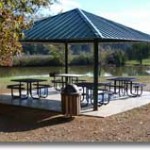This week Mike the Pole Barn Guru discusses about insulation options, building plans for a back yard pavilion, and steel gauge for a “swing table.”
DEAR POLE BARN GURU: We are well on our way toward breaking ground. Our biggest concerns that we seem to keep going back to are these. We want a tight, dry efficient house. Although we get a little winter we are way more concerned with cooling. I love the dark metal for the roof but my husband thinks it will make the house hotter. Any advice you can offer to achieve our goals would be appreciated. We can afford to do it right but don’t want to overdo. JENNY in ARTEMUS
DEAR JENNY: If you are going to build a fully engineered post frame building, then you should be able to meet with all of your goals. By using flash and batt (https://www.hansenpolebuildings.com/2020/01/flash-and-batt-insulating-barndominium-walls/) for your wall insulation system, you will have tight walls. Kentucky is in Climate Zone 4 where ceiling R-value must be at least R-49 by Code. For the small difference in investment, I would suggest blowing in R-60 and using 22″ energy heel trusses to get full insulation thickness from wall-to-wall. Here in NE South Dakota we have a black steel roof and R-60 attic insulation. Our typical late summer is 90 degree plus days and with our attic insulated as it is, any heat gain from our black roof is negligible. For more information on energy efficiency please read: https://www.hansenpolebuildings.com/2019/11/post-frame-building-insulation/.
 DEAR POLE BARN GURU: First, thanks for this website. I have found it very useful in my research. I work in tech and am not a carpenter, but I have worked construction before and I am taking on building an out door pavilion in our back yard. The dimensions are 20’x14′ hipped roof with posts at 18′ and 12′. I have found a couple of plans online and have purchased them and studied them inside and out to see whether or not I could take this on. I believe that I can. The plans that I have both have a 6 post layout. I would like to modify them a bit to eliminate the center posts and only have 4 posts. I have solved that by using an LVL microlam beam for the roof stringers. My real question though is around knee braces. the plans have knee braces in them, but I would like to not have them if at all possible. I have seen similar construction images that don’t have them. I am planning on using 6×6 posts and notching out the top for the stringers. Would not having braces influence the joinery choice of the stringers? Including a couple files for reference. Thanks for any and all help!! BJ in WASHINGTON
DEAR POLE BARN GURU: First, thanks for this website. I have found it very useful in my research. I work in tech and am not a carpenter, but I have worked construction before and I am taking on building an out door pavilion in our back yard. The dimensions are 20’x14′ hipped roof with posts at 18′ and 12′. I have found a couple of plans online and have purchased them and studied them inside and out to see whether or not I could take this on. I believe that I can. The plans that I have both have a 6 post layout. I would like to modify them a bit to eliminate the center posts and only have 4 posts. I have solved that by using an LVL microlam beam for the roof stringers. My real question though is around knee braces. the plans have knee braces in them, but I would like to not have them if at all possible. I have seen similar construction images that don’t have them. I am planning on using 6×6 posts and notching out the top for the stringers. Would not having braces influence the joinery choice of the stringers? Including a couple files for reference. Thanks for any and all help!! BJ in WASHINGTON
DEAR BJ: Thank you for your kind words. In all reality, when it comes to post frame construction, if you are physically capable and will read assembly instructions then you can successfully erect your own beautiful building. Your structure should be able to be done without a need for knee braces, however it would behoove you to have it designed by a Registered Professional Engineer. In most instances they will save you more money in eliminating inefficiencies than you will pay them for their services. Depending upon your building’s eave height and overall height of your roof, 6×6 columns may or may not be adequate for your purpose, again – your engineer can specify this as well as all needed connections.
DEAR POLE BARN GURU: I was going to make this for a client, probably 2 or 2.5 inch square tubing. Just curious to what thickness I should use? I was thinking 11ga- 1/8 inch thick steel. I just don’t know if that will be strong to enough to support a human. The part they will be hanging from will be about 4 foot wide. BLAKE
DEAR BLAKE: Sizing steel members is most certainly out of my wheelhouse, although I appreciate your inquiry. Given pricing of this unit, I would recommend you consult with a Registered Professional Engineer to size members as well as design connections – since people will be potentially injured (or worse) in event of a failure, you do not want to be in a liability position. My one recommendation would be to have it powder coated to minimize rusting potentialities.






